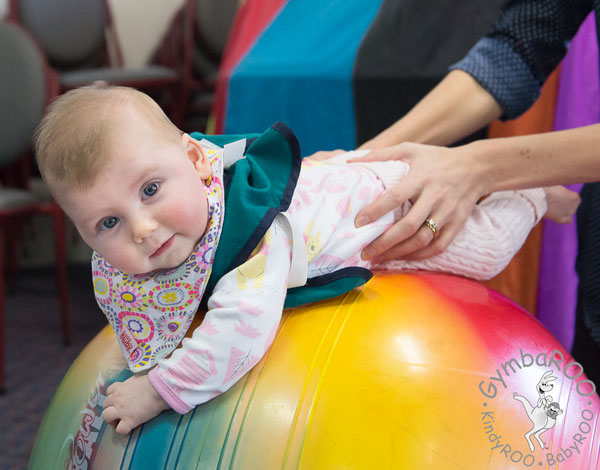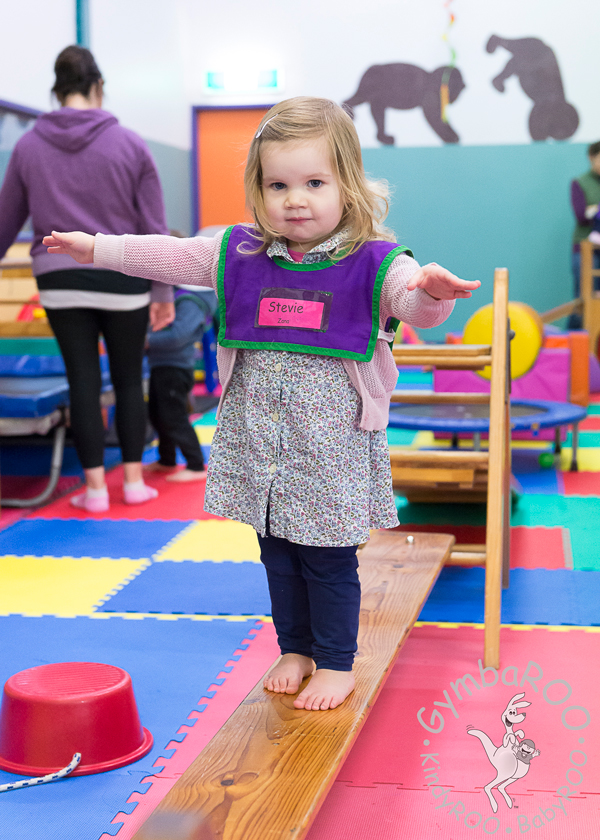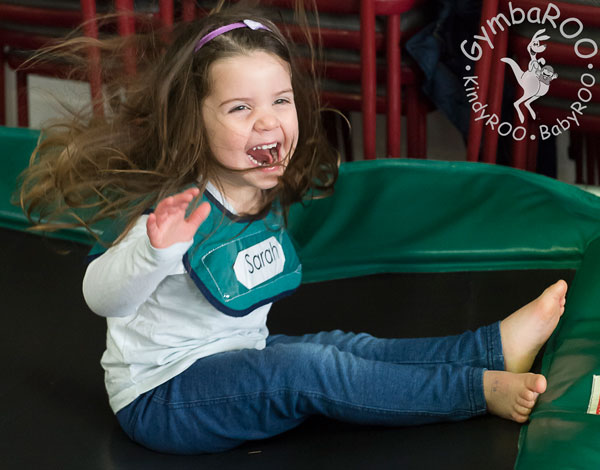Join the thousands of parents already raising smarter, happier babies with our online baby classes: The Active Babies Smart Kids series. Click here.
GymbaROO-KindyROO kids are excelling academically, emotionally, in leadership roles and on the sporting field. Find us at: GymbaROO-KindyROO
In all our GymbaROO-KindyROO classes, from the very young babies to school readiness, we include many different activities that stimulate the vestibular system because of the important role it plays in child development.
Dr Jane Williams and Bindy Cummings
What is the vestibular system?
The first sensory system to fully develop, (by six months after conception), is the vestibular system. This system controls the sense of movement and balance and is the sensory system considered to have the most important influence on the other sensory systems and on the ability to function in everyday life. Directly or indirectly, the vestibular system influences nearly everything we do. It is the unifying system in our brain that modifies and coordinates information received from other systems. The vestibular system functions like a traffic policeman, telling each sensation where and when it should go and stop.
What functions are directly governed by the vestibular system?
1) Auditory functions via the vestibular-cochlear nerve that carries information to the brain from the inner ear.
2) Visual functions via the six pairs of muscles controlling eye movements and fixation of the eyes.
3) Tonic muscle control that holds the neck steady and keeps the eyes focused on a target.
4) Balance and equilibrium functions, telling us where we are in space, whether we are moving or still, how fast we are going and in which direction.
5) The pre-arousal part of the brain is influenced to control alertness and the ability to focus. It can calm or arouse a child’s nervous system.
How should the vestibular system function?
When the vestibular system is organised or various sensory systems become integrated with one another, the nervous system functions in a holistic way. When an infant creeps across the floor or a child climbs over and under obstacles, his entire body works together as a balanced unit. The sensations from these adapted body movements create a well-organised and balanced pattern of activity in the brain. When the whole body and the senses work together in unison, adaptation and learning are easy.
One of the most important things that happen in the brain is the modulation of the vestibular activity. It is the process of increasing or reducing neural activity to keep that activity in harmony with all other functions of the nervous system. All the functions of the brain must be in harmony with each other to produce the most effective and efficient response.
How to tell if the child has a problem with the vestibular system?
A baby can show early signs when not easily developing the postural responses to keep upright. She will find it hard to hold up her head, arms and legs simultaneously when lying on her stomach. The baby may have difficulty rolling over, learning to crawl and creep and be late learning to walk.
Picture four three-year-olds in a GymbaROO class. The first one balances along a balance beam a few times without any effort, looking graceful and she enjoys doing it. The second one has a hard time keeping her balance and repeatedly steps off the beam. The third walks along with arms and body going in all directions and appears clumsy. She looks at her mother and makes some sounds but cannot speak clearly. The fourth child is clinging onto mum, afraid of falling. She holds her mother’s hand tightly. Mother encourages her to try. She walks the beam without falling. Except for the first child, all others are not adequately processing sensory input within their vestibular system. The second has trouble keeping his balance. The third does not speak as well as the others of his age. The fourth child, who feels anxious about falling, may also have other emotional problems.
What kind of vestibular problems can arise?
There are two types of vestibular disorders that commonly interfere with learning and behaviour. One is an overactive vestibular system, when a child’s neurological system cannot regulate the amount of information bombarding the central nervous system, causing it to overload. The child is unable to ignore all the vestibular information entering the system. The brain overreacts to vestibular input.
When a child has an overactive vestibular system, he displays gravitational insecurity and an intolerance to movement. This child is afraid of falling and will take longer to learn to walk stairs. Upside down presents a threat. He feels fear, anxiety or distress whenever he is in a position to which he is unaccustomed. He will take a dislike to swings, slides or spinning activities. He feels safe when both feet are on the ground, does not enjoy walking up or down slopes or over ground that is uneven. He does not like to climb, ride or jump down. He will avoid somersaults or rough-house playing. This child demands constant support from an adult and has problems interacting socially with others. He may seem to be willful and uncooperative and tries to manipulate people and situations. Feeling dizzy, getting a head-and stomachache may be a characteristic.
The other disorder is an under-active vestibular system – when a child’s central nervous system does not receive or correctly process information about movement. The brain under-reacts to vestibular input.
When a child has an underactive vestibular system, she frequently loses balance, shows an inability to sit still and is fidgety, is a ‘bumper and crasher’ and loves to climb and jump off high objects or run fast. She has low muscle tone, displays general clumsiness, craves spinning activities, has trouble knowing where she is in space and the difference between up and down, top and bottom, left and right. She is unsure of which hand to use for throwing, catching or hitting a ball. This child has laterality problems. Knowing and using body parts in coordination can be difficult. Often, she has a delay in learning language. Moving arms and legs against an unstable trunk is difficult. She lacks ability to control eye muscles, which interferes with movement and academic learning. This child seems to tire easily and needs to rest her head frequently. She also often suffers from low self-esteem.
How can we help children to overcome vestibular problems?
We can assist children by engaging them in movements that stimulate the vestibular system. Children with an overactive vestibular system can be encouraged to participate in slow swinging, slow rocking, slow linear movements such as sitting inside a box and being pulled in one direction, linear walking or linear movements such as swimming, jumping on a trampoline and practicing directional change during dancing.
Children with an underactive vestibular system can be encouraged to do some spinning, swinging, jumping on the trampoline, accelerating or decelerating by running zig-zag around cones, rocking, tumbling, somersaults and rolling.
If a child has vestibular problems now, the problems will grow with him. The child may develop strategies to avoid or compensate difficult tasks, he may develop talents that are not dependent on his shaky balance or eye problems, but he will always have to work very, very hard to function smoothly. If you are concerned about your child’s vestibular system, please don’t hesitate to talk to your GymbaROO teacher.
Dr Jane Williams (PhD, BMgt, RN(Paeds)) is the Research and Education General Manager for GymbaROO and KindyROO. Dr Williams is one of Australia’s leading experts on baby and child development. More on Dr Williams here.
Bindy Cummings (B.Ed(Human Movement) Hons) has worked as a teacher, child development consultant, early childhood development lecturer, teacher trainer and INPP & iLS consultant. She is the co-creator of GymbaROO’s Active Babies Smart Kids online series, has authored many published articles on child development. She is working on the content and development GymbaROO’s portal and online training programs, and the creation of new online programs for parents and children. More on Bindy Cummings here.
GymbaROO Images by Studio Z Photography
References: Ayers, Jean A. Sensory Integration and the Child. Miller Lucy Jane, Sensational Kids, Hope and Help for Children with Sensory Processing Disorders. Carol Stock Kranowitz, The Out-of-Sync Child
GymbaROO-KindyROO
Thousands of parents, babies and children are presently involved in our programs and creating rising stars. GymbaROO-KindyROO kids are excelling academically, emotionally, in leadership roles and on the sporting field. Come join all the fun and learning! “GymbaROO – The best decision I ever made for my child.” Classes from 6 weeks old – 7 years GymbaROO KindyROO
Active Babies Smart Kids – Online Baby Classes
GymbaROO-KindyROO’s online series of baby classes is taking the parenting world by storm! It is highly recommended by doctors, paediatricians, early childhood experts and the Maternal Child and Family Health Nurses Association. This series is being called: “The essential guide for parents”. Join the thousands of parents already playing with their babies from birth, in the best way for brain and body development and laying crucial foundations for future learning. What happens in the first year, not only matters, it matters a lot! Enjoy the introductory video below.
Click here: Active Babies Smart Kids online series
Try the first episode FREE: Tummy time + baby fun and development class 1
Enjoy the following GymbaROO-KindyROO articles
GymbaROO-KindyROO: Who, what, where, why and how
All about GymbaROO’s online baby classes for parents and babies: Active Babies Smart Kids
How to raise a smarter, happier baby
Tip-toe walking, knee-walking: Are they ‘normal’?
Why developing your baby’s balance is SO important: Vestibular development
He may not ‘Grow out of it’. A checklist for parents of 0 – 5 year olds
Click here for more GymbaROO-KindyROO article choices.





